UMass Extension's Landscape Message is an educational newsletter intended to inform and guide Massachusetts land care professionals in the management of our collective landscape. Detailed reports from scouts and Extension specialists on growing conditions, pest activity, and cultural practices for the management of woody ornamentals, trees, and turf are regular features. The following issue has been updated to provide timely management information and the latest regional news and environmental data.
Thanks for your continuing interest, and Happy Holidays! This is the final message for 2023; the Landscape Message will resume next March for the 2024 season. To receive immediate notification when the next Landscape Message update is posted, be sure to join our e-mail list
To read individual sections of the message, click on the section headings below to expand the content:
Scouting Information by Region
Environmental Data
The following data was collected on or about November 15, 2023. Total accumulated growing degree days (GDD) represent the heating units above a 50ºF baseline temperature collected via regional NEWA stations (http://newa.cornell.edu) for the 2023 calendar year. This information is intended for use as a guide for monitoring the developmental stages of pests in your location and planning management strategies accordingly.
|
MA Region/Location |
2023 Growing Degree Days |
Soil Temp |
Precipitation |
Time/Date of Readings |
||
| Gain since last report |
2023 total |
Sun |
Shade |
|||
|
CAPE |
155 |
2835 |
46 |
44 |
2.68 |
8:00 AM 11/15/2023 |
|
SOUTHEAST |
143 |
2882 |
50 |
44 |
2.50 |
3:00 PM 11/15/2023 |
|
NORTH SHORE |
112 |
2599 |
40 |
40 |
1.82 |
10:30 AM 11/15/2023 |
|
EAST |
134 |
2984 |
51 |
47 |
1.53 |
4:00 PM 11/15/2023 |
|
METRO |
105 |
2721 |
36 |
35 |
1.41 |
6:00 AM 11/15/2023 |
|
CENTRAL |
101 |
2786 |
43 |
45 |
3.37 |
6:30 AM 11/16/2023 |
|
PIONEER VALLEY |
90 |
2852 |
44 |
46 |
3.18 |
1:00 PM 11/15/2023 |
|
BERKSHIRES |
58 |
2327 |
43 |
42 |
4.27 |
8:30 AM 11/15/2023 |
|
AVERAGE |
112 |
2748 |
44 |
43 |
2.60 |
- |
|
n/a = information not available |
||||||
US Drought Monitor: To close out the season, eastern sections of the Cape as well as the entirety of the Islands are currently designated as D0 (Abnormally Dry), representing less than 5% of the total area of Massachusetts. State map as of Thursday 11/16: https://droughtmonitor.unl.edu/CurrentMap/StateDroughtMonitor.aspx?MA
Regional Notes
Cape Cod Region (Barnstable)
General Conditions:
The average temperature for the period from October 11 to November 15 was 51°F with a high of 80°F on October 28 and a low of 28°F on November 13. During this period there was a warm stretch at the end of October from the 25th-28th when daytime highs were in the 70s; other than that, conditions have been seasonal and over the last week daytime highs have been primarily in the 40s with lows in the 30s. The first widespread freeze occurred on the morning of November 2 and 3, with frequent freezes in the mid- & upper Cape in the past week.
There were several precipitation events during the period ranging from minuscule amounts to an inch of precipitation on October 21. Total precipitation for the period was 2.68 inches. Soil moisture is adequate. Soil temperatures remained above 55°F for the first half of the period and in the last week have dropped below 50°F.
Fall leaf drop has occurred on many species, minus oaks. Heavy needle loss on pitch pine is occurring, possibly exacerbated by needle diseases. Turfgrass was actively growing recently but with the colder temperatures of the last week, the last mowing is imminent. Plants seen in bloom during the period include Korean mums, Montauk daisy, and witchhazel. Some stress bloom has been observed on ornamental cherries and lilac.
Pests/Problems:
Foliar diseases were abundant during the end of the summer and early fall as a result of warm and wet conditions. This led to some premature defoliation on many species like crabapple, birch, poplar, and cherry. Some stress bloom has been observed on lilac – in general this bloom is occurring on plants that were prematurely defoliated (possibly from pseudocercospora leaf spot). Other disease symptoms or signs observed during the period include Nectria fungi on maple. Phytophthora root rot has been confirmed this fall on rhododendron, lavender, arborvitae, and Japanese laurel. Conditions were ideal for phytophthora and other root rots this season.
Insect pests or damage observed during the period include white grub damage to turf, turpentine beetle damage to pitch pine, beech blight aphid on beech, box tree moth damage on boxwood, and scale on euonymus.
It's time to think about winter protection for thin barked trees and shrubs that can be girdled by rabbits or voles.
Southeast Region (Dighton)
General Conditions:
The fall foliage was glorious this season, albeit it seemed to pass by too quickly. Swamp red and sugar maples as well as the few remaining ash trees have dropped all their leaves. Burning bush euonymus are now prominent in their scarlet raiment along roadsides. Lawns are green and but have pretty much stopped growing after the recent morning frosts. The past month has been fairly dry. The total recorded rainfall was only 2.50 inches. We enjoyed a bit of “Indian Summer” at the end of October with a daytime high of 80°F on Saturday, October 28. The late season respite passed too soon when the first hard frosts of the season arrived on November 2nd and 3rd with morning lows of 28°F. The average daytime temperature was 50° F. The highest wind speed was 21 mph on Saturday, October 21st.
Pests/Problems
Claspers, garlic mustard, greater celandine, mare's tails, and a host of other winter germinating weeds are already evident in their hordes awaiting Spring.
North Shore (Beverly)
General Conditions:
Temperatures during this reporting period (second half of October and first half of November) were variable. Day temperatures ranged from the low 40s to the mid 60s and night temperatures ranged from the low-20s to low 50s. Temperatures above 70 degrees were recorded on four days during this period between October 25 and October 28 with the highest temperature of 79˚F recorded on October 28. Temperatures below 32 degrees were recorded on 5 days during the first week of November with the lowest temperature of 20˚F recorded on November 13. The average daily temperature for the period was 48˚F, and Long Hill received 1.82 inches of rainfall in this time. Fall clean up is ongoing throughout the region. Fall color continues in the landscape with foliage colors mainly yellows, oranges and reds despite many leaves falling. The few plants observed in the landscape showing bloom color include: Montauk daisy (Nipponanthemum nipponicum), and ‘Sheffield Pink’ chrysanthemum (Dendranthema x grandiflorum 'Sheffield'). Colorful fruiting plants such as hardy orange (Poncirus trifoliata), beautyberry (Callicarpa americana), Wright viburnum (Viburnum wrightii), and winterberry (Ilex verticillata) are also providing color in the landscape by way of their fruits.
Pests/Problems:
Ticks are active anytime the temperature is above freezing. Take precautions when raking leaves and conduct tick checks after working outdoors. Use repellents containing DEET to protect yourself. Mosquito populations are mostly done for the year. Poison ivy (Toxicodendron radicans) and invasive species such as burning bush (Euonymus alatus) are displaying fall foliage color and seeds in the woods, while unfortunately displacing native plants upon which wildlife depend. Weed piles of (and any decorative arrangements containing) Oriental bittersweet should be bagged or burned for proper disposal. Avoid using Oriental bittersweet on wreaths and other decorative arrangements displayed outdoors. Leaves and mummified fruit from crabapple trees that were diseased should be raked up, removed, and destroyed to reduce the amount of disease pathogens carried over to the next season.
East (Boston)
General Conditions:
It has been a fairly dry, extended fall. From mid-October through mid-November; daytime temperatures averaged 59°F, with overnight lows averaging 43°F. We had a four day stretch from October 25th-28th for which daytime temperatures averaged 79°F, reaching 80°F on both the 26th and the 28th. We had our first light frost November 2nd and 3rd with overnight lows reaching 31°F and 30°F. We had a season ending killing frost on November 12th and 13th with overnight temperatures reaching 26°F and 23°F and daytime highs of 42°F and 46°F. We received 1.53 inches of precipitation over the past five weeks. Fall color has been inconsistent. Ilex verticillata (winterberry) are providing an abundant display of berries.
Pests/Problems:
Total precipitation for October was 1.47 inches. Midway through November we have recorded only 0.21 inches. Despite the wet growing season, soils are drying out.
Metro West (Acton)
General Conditions:
We’ve experienced a range of weather during this past reporting period and for the months of October and November. A string of high temperatures of 73°F, 79°F, 77°F, and 81°F were recorded on the 25th , 26th, 27th, and 28th of October, and most recently, a high of 66°F was recorded on November 7th. The first frost for the season was recorded on October 31st, even though it was a light one and heavier frosts have since covered the landscape. Morning temperatures have dipped into the teens with 19°F and 18°F recorded on November 12th and 13th. October’s average monthly rainfall is 4.32” and a total of 1.51” of rain was recorded for the month. For the month of November, the average rainfall is 4.43” and the precipitation recorded for the month so far for this area is a total of only 0.2”.
Pests/Problems:
Euonymus alatus (burning bush) is aglow now, very showy with its brilliant red foliage. This non-native invasive woody plant is found planted in many landscapes as well as seen invading the forest where it chokes out native understory plants, destroying the ecosystem. They are hard to miss and not at all attractive once you learn how damaging they are!
Central Region (Boylston)
General Conditions:
Weather during this reporting period was variable, with highs into the upper 70’s and lows down to 25°F. Soils remain saturated thanks to more than 3 inches of rain. Nearly half the precipitation fell during an extended weather event on October 21 that brought more than 1.5 inches of rain. The first snow of the season fell Monday night into Tuesday morning. It was little more than a dusting, but it collected on cold surfaces. Fall color has been variable, with many trees and ornamental shrubs coloring up and dropping foliage early, while others were very late and still holding color. The first frost of the season was quite late, on October 31, when we experienced our first freeze of the season as well. There are very few flowers remaining throughout the region, with the exception of some late blooming asters.
Pests/Problems:
During late season garden cleanup, evidence of jumping worm activity has been widespread. Worm castings are abundant. This season’s wet weather seems to have led to a boom in their populations. With the wet season, foliar disease pressure was high. Removing fallen leaves is important in limiting disease pressure next season on plants like flowering dogwood (Cornus florida) to prevent dogwood anthracnose from being worse next season.
Pioneer Valley (Amherst)
General Conditions:
The growing season is complete and plants have entered their dormant stage throughout the region as we conclude the series of Landscape Messages for 2023. October ended with a heavy dose of precipitation from storms on 10/20–21 (>1.5”) and 10/29–30 (~1”). The moisture and mild temperatures late in the month meant mosquitoes were still active. Scattered snow showers across western Massachusetts occurred on 11/1, and accumulations of several inches persisted for a few days in the western hilltowns. The light snow was immediately followed by a hard freeze on 11/2 with lows dipping into the mid-20s. This represented the first sub-freezing temperature for many areas of the tri-counties. While the fall foliage season will not be remembered as one of the very finest, there were still an excess of trees that put on a spectacular display. Red maple, Japanese maple, Kousa dogwood, Japanese stewartia, black birch, witchhazel, and shagbark hickory were just a few of the species that had excellent color this year. Interestingly, many ginkgos dropped green leaves with no hint of color change. Several female ginkgos on the UMass campus are adorned with the large, tan/orange-colored fruits that encircle the branches and twigs. Also, a variety of deciduous shrubs are still holding green leaves, such as forsythia, winterberry and Virginia sweetspire. Arborvitae seem to have had a significant shed of older needles this year along with a strong crop of cones.
While the first half of November was fairly dry, the low sun angle, seasonable temperatures and ample soil moisture has eliminated any need for supplemental water for new transplants at this time. According to the National Center for Environmental Information, the average precipitation across Massachusetts from June through September this year was 26.18”, making it the second wettest on record. More than a third of this rainfall occurred in July (9.11” statewide average), yet shockingly, this figure came in a distant second to July 2021, when 10.41” was recorded. Record or not, it was an extremely wet growing season and this was beneficial for some trees and detrimental to others. Based on the amount of annual growth that accrued this year, it appears the majority of our landscape trees thrived as a result of the abundant rainfall. The slower pace of the winter season is a good time to assess tree branch structure and overall form, especially for deciduous hardwoods. Dead twigs and branches can be scouted and pruned at any time through the fall and winter season. However, pruning for size and form is best left until later in the winter or early spring. Significant pruning in the autumn season can delay or disrupt cold acclimation for conifers and some hardwoods. Dormant season pruning in the winter also reduces sap flow from branch wounds that may attract sap feeding beetles that transmit vascular wilt diseases (e.g. Dutch elm disease and oak wilt). As the calendar year winds down, I’m deeply thankful for everything that trees provide me, both physically and mentally. While the landscape has taken on its stark appearance, there is still much to appreciate and plan for next year.
Pests/Problems:
One of the most conspicuous diseases this autumn season was Pseudocercospora leaf blight of lilac. Young and mature plants throughout the area suffered from serious leaf blotching and premature leaf shedding in late summer. As a result of the early leaf loss, several lilacs in Hampshire County were observed flowering in early October with some flushing new leaves. Scattered autumn blooms are a frequent occurrence on spring-flowering shrubs like azalea, rhododendron, etc. but some tip dieback can be expected where tender new growth emerged. The flowering was scattered throughout the canopy but may impact the quality of the bloom next spring. Regardless, lilacs are extremely hardy shrubs that are difficult to intentionally eradicate. Most plants should appear healthy next year despite the early leaf loss this year. Symptoms of Rhizosphaera needle cast on spruce (brown to purple to blackened needles) were common this autumn season. Drought stress stimulates needle cast diseases and while drought was unlikely this year, the abundant rain and high humidity helped to promote disease development and spread. Pruning and removal of lower canopy branches, especially interior branches that are heavily shaded, can help to reduce inoculum and improve aesthetics. Rhizosphaera kalkhoffii is the primary species on spruce and is uncommon on other conifers. Thus, an infected spruce does not pose a serious threat to nearby pines, true firs, hemlocks, etc. Applications of deer and rabbit repellents should have been made by now. Ensure applications of liquid repellents to the foliage occur at temperatures above freezing to avoid contact freeze injury. Rabbit injury on young eastern hemlocks and deciduous azaleas has been observed in the landscape. Discourage deer browse on yew and arborvitae with repeated applications of repellents over the winter months, on a four to six week interval (when temperatures allow).
Berkshire Region (West Stockbridge)
General Conditions:
Seemingly, the weather becomes more erratic every year. In late October (10/25-10/28), Berkshire County had a 4 day stretch of temperatures well into the upper 70s, setting a record high at some sites on the 25th of the month. Maximum temperatures in the interval from the last scouting on October 11th to the present (November 15) at the 3 NEWA all occurred on October 25th: 79°F in North Adams, 78°F in Richmond, and 76°F in Pittsfield. The first frost of the season occurred at most sites on either October 23 or 24th. The low temperatures for the scouting period all occurred on November 13th: 18°F in Richmond, and 19°F in both North Adams and Pittsfield. Rainfall totals for the period were 3.78 inches in Richmond, and 4.26 in both Pittsfield and North Adams. Soil moisture currently has been more than adequate for landscape plants as they move into their dormant period. This bodes well for fall planted specimens. Turfgrass grew rapidly during the early days of the recent scouting period and is now also heading into dormancy.
Pests/Problems:
At this time, there are no significant problems in the landscape though horticulturist Amie Combs observed a significant infestation of beech blight aphids (Grylloprociphilus imbricator) on branches of several American beech trees in the village of Monterey. Black-legged ticks remain active and it is not unusual for those working in the landscape to pick up ticks on their clothing or body. Jumping worms (Amynthas spp.) are moving about on sunny days and are seemingly drawn to the warmth of asphalt surfaces, as witnessed by the large number of worms flattened by vehicles. The most annoying of insects are those which are invading our homes.
Regional Scouting Credits
- CAPE COD REGION - Russell Norton, Horticulture and Agriculture Educator with Cape Cod Cooperative Extension, reporting from Barnstable.
- SOUTHEAST REGION - Brian McMahon, Arborist, reporting from the Dighton area.
- NORTH SHORE REGION - Geoffrey Njue, Green Industry Specialist, UMass Extension, reporting from the Long Hill Reservation, Beverly.
- EAST REGION - Kit Ganshaw & Sue Pfeiffer, Horticulturists reporting from the Boston area.
- METRO WEST REGION – Julie Coop, Forester, Massachusetts Department of Conservation & Recreation, reporting from Acton.
- CENTRAL REGION - Mark Richardson, Director of Horticulture reporting from New England Botanic Garden at Tower Hill, Boylston.
- PIONEER VALLEY REGION - Nick Brazee, Plant Pathologist, UMass Extension Plant Diagnostic Lab, reporting from Amherst.
- BERKSHIRE REGION - Ron Kujawski, Horticultural Consultant, reporting from Great Barrington.
Woody Ornamentals
Diseases
Recent pests, pathogens, or problems of interest seen in the UMass Extension Plant Diagnostic Lab, a select few:
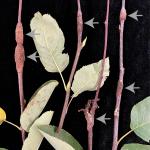
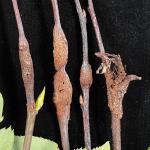 Cedar–Quince rust, caused by Gymnosporangium clavipes, on serviceberry (Amelanchier canadensis). The shrub is young and one of four that were transplanted in July at a residential site with part sun and drip irrigation. Swollen stem galls with protruding orange-pink spore masses (aecia) were observed on the stems but the plants appeared otherwise healthy. At the time of submission, when the fungus was done sporulating, the galls appeared smooth (see photos). Cedar–quince rust is one of the most damaging rust diseases in the managed landscape. These gall-like cankers can cause a progressively worsening dieback in the canopy of serviceberry. Cankered stems should be pruned out to reduce inoculum.
Cedar–Quince rust, caused by Gymnosporangium clavipes, on serviceberry (Amelanchier canadensis). The shrub is young and one of four that were transplanted in July at a residential site with part sun and drip irrigation. Swollen stem galls with protruding orange-pink spore masses (aecia) were observed on the stems but the plants appeared otherwise healthy. At the time of submission, when the fungus was done sporulating, the galls appeared smooth (see photos). Cedar–quince rust is one of the most damaging rust diseases in the managed landscape. These gall-like cankers can cause a progressively worsening dieback in the canopy of serviceberry. Cankered stems should be pruned out to reduce inoculum.
Canopy dieback of Emerald Green arborvitae (Thuja occidentalis ‘Smaragd’) due to needle blight and root zone restriction. The trees are approximately 10-years-old and have been present at the site for six years. They reside in an elevated, rectangular-shaped, brick planter box. The rooting area is extremely limited given the size of the trees. Despite drip irrigation, fungicide application for needle blight control, and otherwise good care, the trees continue to exhibit symptoms of stress and dieback. Pestalotiopsis and Phyllosticta, two very common needle blight pathogens of Thuja, were present on the symptomatic stems and needles. However, the lack of rooting space has likely led to circling and possibly girdling roots, predisposing the trees to decline.
Twig and branch cankering in the lower to mid-canopy of a Cicilian fir (Abies cilicica) caused by Neonectria. The tree, which has a tight, conical shape like a Christmas tree, is approximately 45-years-old and has been present at the site for 20 years. The site is described as full sun in loam soils and supplemental irrigation provided by lawn sprinklers. Deep watering with a pulse sprinkler has been used during extended dry periods. In spring of 2022, needles in the lower canopy began prematurely shedding, and over time the symptoms spread upward in the canopy. The top 10’ is considered healthy but the lower 30’ has shed almost all needles with only sparse tufts of new growth at the shoot tips. Neonectria canker of true fir is not an overly common disease but the damage can be significant when the pathogen is well established. The twigs and small branches had stained vascular tissue and the pathogen was readily incubated. Live shoots and needles, representing 2022 and 2023, were highly stunted, reflecting the level of stress the tree is enduring.
Needle loss and twig cankering in the canopy of a mature Japanese yew (Taxus cuspidata) hedge due to pruning stress, Cryptocline needle blight (Cryptocline taxicola), stem cankering caused by Pestalotiopsis and possible soil saturation. The hedge is approximately 40-years-old and resides in full sun with well-drained, loam soils. In mid-April, the hedge was pruned hard on one side as it had grown over an adjacent walkway. It was pruned back to bare wood on one side since yews will readily produce new growth from dormant buds. While the soils have good drainage, the home’s basement sump pump drains in the same area as the hedge. Due to the heavy rains this summer, the sump pump was running frequently. Yews do not tolerate saturated soils very well, especially in conjunction with other stresses. During the autumn season, needle browning and twig dieback appeared throughout the canopies. Cryptocline is one of the few pathogens of concern on yew while Pestalotiopsis is an opportunist that attacks stressed and weakened plants. It may have been present prior to the hard prune and exploited the many pruning cuts to cause further disease.
Report by Nick Brazee, Plant Pathologist, UMass Extension Plant Diagnostic Lab, UMass Amherst
Insects and Other Arthropods
UMass Extension’s Professional Insect & Mite Management Guide for Woody Plants is Now Available!
Click here to use it now: https://ag.umass.edu/insectmiteguide
This guide is intended for use by professional land managers, including but not limited to: landscapers; arborists; urban and community foresters; tree wardens; local, state, and federal land managers; groundskeepers; and any landscape practitioner who is managing the health of trees and shrubs.
Over 200 potential insect or mite pests of ornamental trees and shrubs are included in this free online and searchable guide. New insects and insect relatives will be added as information becomes available.
UMass Extension wants to hear from you! Please complete this brief survey after you use the Professional Insect & Mite Management Guide to provide us with valuable feedback. Your feedback will be used to prioritize updates to this resource now and in the future: https://forms.gle/u2wiLpGijyirkQ9k7.
Interesting Insects Reported Recently:
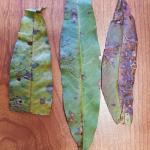
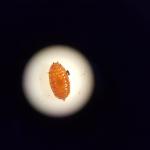 Peach Leaf-miner: Phytomyza persicae is a leafmining species of agromyzid fly. The peach leaf-miner was detected in a sample sent to the UMass Plant Diagnostic Laboratory and confirmed with the assistance of Charley Eiseman and Richard Cowles.
Peach Leaf-miner: Phytomyza persicae is a leafmining species of agromyzid fly. The peach leaf-miner was detected in a sample sent to the UMass Plant Diagnostic Laboratory and confirmed with the assistance of Charley Eiseman and Richard Cowles.
Eggs are elliptical and white and 0.12 by 0.30 mm in size. Eggs are laid singly beneath the lower epidermal layer of the leaf. Larvae are white and spend all of their time in their leaf mines. Larvae progress through three instar stages. First instar larvae are 0.70 mm in size and found within blotch-type or linear mines up to 3/4 cm. in length. Second instar larvae are 0.40 to 1.25 mm long and found in mines up to 3 cm. in length. Third instar larvae are 1 to 2.45 mm long found in leaf mines ranging from 3/4 to 5 cm long. Pupae are in a puparium near the very end of the leaf mine. Puparia are 1.66 mm long and 0.89 mm wide, and are dark brown with prominent posterior and anterior spiracular processes. Adults emerge from the puparium as well as the leaf. Adult male fly's wingspans are 1.4 mm long and adult females are 1.5 mm long. Both are grayish black in color and further described in Dowdy (1954).
In Ohio, Dowdy (1954) reports the following as the life cycle of this insect: Adults emerge and are short lived, likely only active for 6 or so days. Adult activity occurs mostly on warm, sunny days with flight activity short and rapid. Mating occurs within 24 hours of adult emergence. Adult females lay 11-27 or more eggs. Eggs hatch in approximately 8 days and larval mines appear, under warm weather conditions. Larvae of each of the three instars are associated with different types of mines. In Ohio in 1952, three complete generations per year were observed, while in 1954 a partial fourth generation occurred.
Wild black cherry, cultivated cherries, and peaches are noted as host plants (Dowdy, 1954). Up to 13 varieties of peaches have been noted as suitable host plants. Adult females will puncture numerous holes in the foliage of susceptible host plants with their ovipositors; however, this behavior may not be associated with egg laying. Leaf mining is caused by the feeding larvae. On cherry trees, mined leaves may lead to considerable early leaf loss. On peach trees, very little leaf loss (defoliation) is recorded due to the mining activity of this species. In Dowdy (1954), records from 1952 and 1953 report that the damage caused by this insect in Ohio was not particularly injurious to healthy peach trees. However, they noted a few trees with 50% or more of their leaves mined or punctured by fly ovipositors may have been more seriously damaged by this insect. The leaf mines themselves are very difficult to detect, even upon close inspection in the field. Halticoptera aenae was noted by Dowdy (1954) as a major parasitoid of the peach leaf-miner, however a long list of additional natural enemies of this insect is provided in that publication.
Current Nuisance Problems of Note:
- Deer Tick/Blacklegged Tick: Ixodes scapularis adults are active all winter and spring, as they typically are from October through May, and “quest” or search for hosts at any point when daytime temperatures are above freezing. Engorged females survive the winter and lay 1,500+ eggs in the forest leaf litter beginning around Memorial Day (late May). For images of all deer tick life stages, along with an outline of the diseases they carry, visit: https://www.capecod.gov/departments/cooperative-extension/programs/ticks-bugs/ or https://web.uri.edu/tickencounter/species/blacklegged-tick/.
Anyone working in the yard and garden should be aware that there is the potential to encounter deer ticks. The deer tick or blacklegged tick can transmit Lyme disease, human babesiosis, human anaplasmosis, and other diseases. Preventative activities, such as daily tick checks, wearing appropriate clothing, and permethrin treatments for clothing (according to label instructions) can aid in reducing the risk that a tick will become attached to your body. If a tick cannot attach and feed, it will not transmit disease. For more information about personal protective measures, visit: https://www.capecod.gov/departments/cooperative-extension/programs/ticks-bugs/.
The Center for Agriculture, Food, and the Environment provides a list of potential tick identification and testing resources.
*In the news: UMass Amherst has now been designated as the location for the New England Center of Excellence in Vector-Borne Diseases (NEWVEC). This CDC (Centers for Disease Control and Prevention) funded center will work to reduce the risk of vector-borne diseases spread by ticks, mosquitoes, and other blood-sucking insects or insect relatives in New England. For more information and to contact NEWVEC, visit: https://www.newvec.org/. To contact the center for more information about their Spring 2023 Project ITCH (“Is Tick Control Helping”), visit: https://www.newvec.org/itch
Woody ornamental insect and non-insect arthropod pests to consider, a selected few:
Highlighted Invasive Insects & Other Organisms Update:
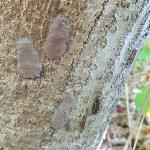 Spotted Lanternfly: (Lycorma delicatula, SLF) is a non-native, invasive insect that feeds on over 103 species of plants, including many trees and shrubs that are important in our landscapes.
Spotted Lanternfly: (Lycorma delicatula, SLF) is a non-native, invasive insect that feeds on over 103 species of plants, including many trees and shrubs that are important in our landscapes.
As of November 2023, the MA Department of Agricultural Resources (MDAR) has confirmed the presence of additional populations of spotted lanternfly in Massachusetts. This brings the total established populations of spotted lanternfly in Massachusetts to those in the following communities: Agawam, Springfield, Holyoke, Worcester, Shrewsbury, Fitchburg, Southborough, Ashland, Wellesley, Weston, and Chelmsford, MA. For a map of these locations, visit: https://experience.arcgis.com/experience/a25afa4466a54313b21dd45abc34b62d/page/Page-2/?views=Spotted-Lanternfly.
As a reminder, there is no reason to be preemptively treating for this insect in other areas of Massachusetts. If you suspect you have found spotted lanternfly in additional locations, please report it immediately to MDAR here. If you are living and working in the above listed areas, please be vigilant and continue to report anything suspicious. Additionally, information about managing spotted lanternfly is provided in the Spotted Lanternfly Management Guide for Professionals, below.
For More Information:
From UMass Extension:
Spotted Lanternfly Management Guide for Professionals
*Note that management may only be necessary in areas where this insect has become established in Massachusetts and if high value host plants are at risk. Preemptive management of the spotted lanternfly is not recommended.
Check out the InsectXaminer Episode about spotted lanternfly adults and egg masses!
From the MA Department of Agricultural Resources (MDAR):
Spotted Lanternfly Fact Sheet and Map of Locations in MA
Spotted Lanternfly Management Guide for Homeowners in Infested Areas
*New*: Spotted Lanternfly Look-alikes in MA
*New*: Spotted Lanternfly Egg Mass Look-alikes
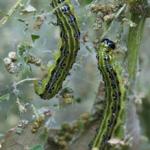
 Box Tree Moth: staff with the Mass. Dept. of Agricultural Resources (MDAR) and the USDA have recently confirmed several instances of boxwood shrubs on Cape Cod that were infested with the invasive pest known as box tree moth (Cydalima perspectalis). The finds have all been in established plantings (2 years old or more). It is unclear how the moths were introduced to the area or how widespread this pest is; USDA is currently working to delimit the infestation.
Box Tree Moth: staff with the Mass. Dept. of Agricultural Resources (MDAR) and the USDA have recently confirmed several instances of boxwood shrubs on Cape Cod that were infested with the invasive pest known as box tree moth (Cydalima perspectalis). The finds have all been in established plantings (2 years old or more). It is unclear how the moths were introduced to the area or how widespread this pest is; USDA is currently working to delimit the infestation.
The main host of box tree moth is boxwoods (Buxus spp.), though in their native range, the moths will also attack burning bush (Euonymus alatus) and a few other uncommon species, if boxwood is not available. Box tree moths can cause complete defoliation of boxwoods, eventually killing entire shrubs. We encourage you to review the following fact sheet from the USDA to learn more about this pest, including how to recognize the adult moths, caterpillars, and eggs: ![]() Box Tree Moth Pest Alert
Box Tree Moth Pest Alert
If you grow, sell, or install boxwoods, please inspect them for any signs of this pest, and report any finds to https://massnrc.org/pests/report.aspx
More information about box tree moth, including management options, is now available from UMass Extension at: https://ag.umass.edu/landscape/fact-sheets/box-tree-moth.
- Asian Longhorned Beetle: (Anoplophora glabripennis, ALB) Look for signs of an ALB infestation which include perfectly round exit holes (about the size of a dime), shallow oval or round scars in the bark where a female has chewed an egg site, or sawdust-like frass (excrement) on the ground nearby host trees or caught in between branches. Be advised that other, native insects may create perfectly round exit holes or sawdust-like frass, which can be confused with signs of ALB activity. Signs of ALB activity (such as damage to trees) may be easier to see in the wintertime when leaves have fallen off of susceptible host trees.
The regulated area for Asian longhorned beetle is 110 square miles encompassing Worcester, Shrewsbury, Boylston, West Boylston, and parts of Holden and Auburn. If you believe you have seen damage caused by this insect, such as exit holes or egg sites, on susceptible host trees like maple, please call the Asian Lonbghorned Beetle Eradication Program office in Worcester, MA at 508-852-8090 or toll free at 1-866-702-9938.
Report an Asian longhorned beetle find online or compare it to common insect look-alikes here.
 Emerald Ash Borer: (Agrilus planipennis, EAB) has been detected throughout much of Massachusetts and it was recently detected for the first time in Barnstable County. A map of these locations across the state is provided by the MA Department of Conservation and Recreation at https://storymaps.arcgis.com/stories/b60f63199fa14805a8b9f7c82447a25b.
Emerald Ash Borer: (Agrilus planipennis, EAB) has been detected throughout much of Massachusetts and it was recently detected for the first time in Barnstable County. A map of these locations across the state is provided by the MA Department of Conservation and Recreation at https://storymaps.arcgis.com/stories/b60f63199fa14805a8b9f7c82447a25b.
This wood-boring beetle readily attacks ash (Fraxinus spp.) including white, green, and black ash and has also been found developing in white fringe tree (Chionanthus virginicus) and has been reported in cultivated olive (Olea europaea). Signs of an EAB infested tree may include D-shaped exit holes in the bark (from adult emergence), “blonding” or lighter coloration of the ash bark from woodpecker feeding (chipping away of the bark as they search for larvae beneath), and serpentine galleries visible through splits in the bark, from larval feeding beneath. It is interesting to note that woodpeckers are capable of eating 30-95% of the emerald ash borer larvae found in a single tree (Murphy et al. 2018). Unfortunately, despite high predation rates, EAB populations continue to grow. However, there is hope that biological control efforts will eventually catch up with the emerald ash borer population and preserve some of our native ash tree species for the future.
- Jumping Worms: Amynthas spp. earthworms, collectively referred to as “jumping or crazy or snake” worms, overwinter as eggs in tiny, mustard-seed sized cocoons found in the soil or other substrate (ex. compost). Adult worms are killed by frost, and their activity should be at or near an end for 2023.
For More Information, see these UMass Extension Fact Sheets:
Earthworms in Massachusetts – History, Concerns, and Benefits
Jumping/Crazy/Snake Worms – Amynthas spp.
A Summary of the Information Shared at UMass Extension’s Jumping Worm Conference in January 2022
Invasive Jumping Worm Frequently Asked Questions (Over 70 Questions and their Answers)
Tree & Shrub Insect Pests (Native and Invasive):
 Bagworm: Thyidopteryx ephemeraeformis eggs are preparing to overwinter in the bags of dead females. This particularly beautiful bagworm bag was photographed by Gino Fellini in Plymouth County, MA on 10/30/2023 and shared by the MA Department of Agricultural Resources. Love those juniper berry decorations!
Bagworm: Thyidopteryx ephemeraeformis eggs are preparing to overwinter in the bags of dead females. This particularly beautiful bagworm bag was photographed by Gino Fellini in Plymouth County, MA on 10/30/2023 and shared by the MA Department of Agricultural Resources. Love those juniper berry decorations!- Eastern Spruce Gall Adelgid: Adelges abietis prefers to form galls on Norway spruce, but may also be found on black, Colorado blue, Engelmann, red, or white spruce. By late summer, these galls dry out, crack open, and the nearly mature nymphs emerge. Once "on the outside", these nymphs develop into winged females who will lay another crop of eggs coated in white woolly wax, which will hatch into the nymphs who will spend the winter near a terminal twig or dormant bud.
- Fall Home-Invading Insects: Various insects, such as ladybugs, boxelder bugs, seedbugs, and stink bugs seek overwintering shelter in warm places such as homes. While such invaders do not cause any measurable structural damage, they can become a nuisance, especially when they are present in large numbers. At this time, the best remedy is vacuuming them up and disposing of them either in a vacuum bag or outdoors.
- Fletcher Scale: Parthenolecanium fletcheri is found on Taxus spp., arborvitae, juniper, and others. Nymphs are preparing to overwinter on host plant needles or twigs.
- Larch Casebearer: Coleophora laricella may be found on European or North American larch (Larix) species. Larvae of this species are preparing to overwinter in a whitish, cigar-shaped case that may look like a dead needle attached to host plant branches or near the base of host plant buds. Caterpillars will resume feeding when temperatures warm next spring.
- Locust Borer: Megacyllene robiniae is native to North America and larvae will overwinter inside of their host tree.
- Magnolia Scale: Neolecanium cornuparvum nymphs are preparing to overwinter on one and two year old twigs of their host plants. These include cucumber, lily, saucer, and star magnolias.
- Poplar and Willow Borer: Cryptorhynchus lapathi weevils are preparing to overwinter as larvae of various instars in the sapwood of their host plants which includes alder, birch, cottonwood, poplar, and willow.
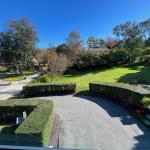
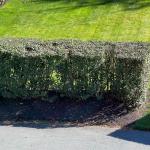
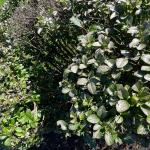 Privet Thrips: Dendrothrips ornatus feeding damage on the upper surface of host plant leaves is currently very apparent. Fed upon leaves appear grayish in color with chlorotic spots. Significant damage to a privet hedge that had been treated with imidacloprid was submitted to the UMass Plant Diagnostic Laboratory, as shown in these photos. Imidacloprid is not recommended for the management of thrips and, for some species, has been implicated in thrips resistance and population resurgence.
Privet Thrips: Dendrothrips ornatus feeding damage on the upper surface of host plant leaves is currently very apparent. Fed upon leaves appear grayish in color with chlorotic spots. Significant damage to a privet hedge that had been treated with imidacloprid was submitted to the UMass Plant Diagnostic Laboratory, as shown in these photos. Imidacloprid is not recommended for the management of thrips and, for some species, has been implicated in thrips resistance and population resurgence.
Concerned that you may have found an invasive insect or suspicious damage caused by one? Need to report a pest sighting? If so, please visit the Massachusetts Introduced Pests Outreach Project.
Reported by Tawny Simisky, Extension Entomologist, UMass Extension Landscape, Nursery, & Urban Forestry Program
Landscape Weeds
As the end of the growing season has arrived, there are not many weed management activities to be done. Management of woody invasives is close to being the only game in town. This would include cut-stem or basal bark treatment for plants such as Oriental bittersweet, shrub honeysuckle, porcelainberry, and buckthorn.
Now is the time for “end of the growing season reflection and self evaluation.” This process should focus on every aspect of your weed management program. Begin with questions about your weed management experience this season such as “what worked great?”, what was just okay but could be better?” and “what was a complete failure?.” As you evaluate your weed management program(s), be completely honest with yourself. While you might buy your line(s) of “bovine fertilizer”, your customers may not. If weaknesses in your weed program are identified, note them and why they may not have performed to expectations. This exercise will be valuable as you research strategies to improve while planning for the next growing season. If there happens to be a pattern of the same low performing strategies, then it is likely time to switch to another product or strategy. Remember: “doing the same thing over and over and expecting different results is the definition of humanity”… oh, wait … nevermind, that works too.
Reported by Randy Prostak, Weed Specialist, UMass Extension Landscape, Nursery, & Urban Forestry Program
Additional Resources
Pesticide License Exams - The MA Dept. of Agricultural Resources (MDAR) is now holding exams online. For more information and how to register, go to: https://www.mass.gov/pesticide-examination-and-licensing.
To receive immediate notification when the next Landscape Message update is posted, join our e-mail list or follow us on Facebook.
For a complete listing of landscape, nursery, and urban forestry program upcoming events, see our calendar at https://ag.umass.edu/landscape/upcoming-events.
For commercial growers of greenhouse crops and flowers - Check out UMass Extension's Greenhouse Update website.
For professional turf managers - Check out our Turf Management Updates.
For home gardeners and garden retailers - Check out our home lawn and garden resources.
Diagnostic Services
UMass Laboratory Diagnoses Landscape and Turf Problems - The UMass Extension Plant Diagnostic Lab is available to serve commercial landscape contractors, turf managers, arborists, nurseries and other green industry professionals. It provides woody plant and turf disease analysis, woody plant and turf insect identification, turfgrass identification, weed identification, and offers a report of pest management strategies that are research based, economically sound and environmentally appropriate for the situation. Accurate diagnosis for a turf or landscape problem can often eliminate or reduce the need for pesticide use. For sampling procedures, detailed submission instructions and a list of fees, see the Plant Diagnostic Laboratory web site.
Soil and Plant Nutrient Testing - The University of Massachusetts Soil and Plant Nutrient Testing Laboratory is located on the campus of the University of Massachusetts at Amherst. Testing services are available to all. The lab provides test results and recommendations that lead to the wise and economical use of soils and soil amendments. For more information, including current turn-around times, visit the UMass Soil and Plant Nutrient Testing Laboratory web site. The lab is currently accepting orders for Routine Soil Analysis (including optional Organic Matter, Soluble Salts, and Nitrate testing), Particle Size Analysis, Pre-Sidedress Nitrate (PSNT), Total Sorbed Metals, and Soilless Media (no other types of soil analyses available at this time). Check for current turnaround time. Please plan for the fact that date of receipt in the lab is affected by weekends, holidays, shipping time, and time for UMass Campus Mail to deliver samples to the lab.
Tick Testing - The UMass Center for Agriculture, Food, and the Environment provides a list of potential tick identification and testing options at: https://ag.umass.edu/resources/tick-testing-resources.
Acknowledgements: UMass Extension gratefully acknowledges the support of the following funding sources for the production of the Landscape Message –
- The Massachusetts Nursery and Landscape Association Fund
- The Massachusetts Department of Conservation and Recreation, Award #ISADCR28219926UMA23A
- Stakeholders like you! The Landscape Message is partially supported by educational program user fees.